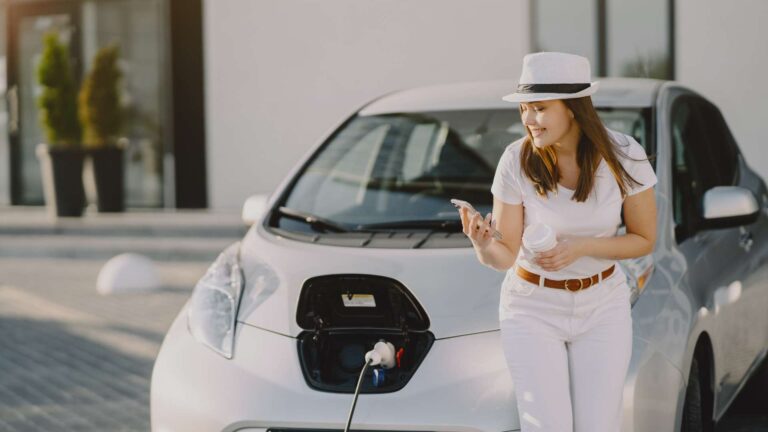Table of Contents
Electric vehicles have moved from niche to mainstream in the United States. Just a few years ago, they made up a small percentage of new car sales. In 2025, EV adoption has accelerated dramatically, supported by tax incentives, infrastructure growth, and consumer interest in sustainable technology. Owning an electric car is no longer unusual, with over a dozen automakers offering EVs across all price ranges.
This surge in popularity brings new questions about insurance. EV owners faced higher premiums for years due to limited data, costly repairs, and specialized parts. But 2025 looks different. Insurers now have more experience with EV claims, automakers are building partnerships with insurers, and the industry is adapting to the realities of EV ownership. Insurance for electric vehicles: what’s different in 2025 — This blog explores everything you need to know.
Why EV Insurance Is Different From Standard Car Insurance
Higher Repair and Replacement Costs
Electric vehicles are built differently from gasoline-powered cars. While they require less routine maintenance, they can be more expensive to repair. The most significant cost factor is the battery. EV batteries cost thousands of dollars to replace; in some cases, they make up as much as 40 percent of the vehicle’s value. Even minor accidents that damage a battery can result in extremely high claims.
Additionally, EVs rely heavily on advanced electronics and sensors. Replacing or recalibrating a single sensor in an advanced driver-assistance system (ADAS) can cost far more than repairing conventional components. These realities contribute to higher insurance costs compared to some traditional vehicles.
Specialized Repair Networks
Another difference is repair availability. Not every body shop is certified to repair EVs, and those that are may charge more due to specialized training and equipment. Longer wait times for repairs can increase the insurer’s costs for rental car coverage, which also influences premiums.
Safety Features and Tech Dependencies
On the other hand, EVs are packed with safety technology that can reduce accident frequency. Features like automatic emergency braking, lane-keeping assistance, and adaptive cruise control mean fewer claims overall. However, when these systems are damaged, the cost of fixing them is much higher. Insurers balance these factors when setting EV premiums.
Key Changes in EV Insurance in 2025
Falling Premium Gaps
For years, EVs were significantly more expensive to insure than comparable gasoline cars. That gap is shrinking in 2025. As insurers collect more claim data and parts become more widely available, premiums stabilize. In some cases, insuring a mainstream EV like the Tesla Model 3 or Chevrolet Bolt is only slightly more expensive than insuring a similar gas-powered sedan.
Battery Coverage Enhancements
One of the biggest changes in 2025 is the introduction of battery-specific coverage options. Insurers now recognize that batteries are the most valuable part of an EV. Many policies include endorsements covering battery damage, degradation, or replacement outside of warranty. This provides peace of mind for EV owners who worry about the cost of replacing such a critical component.
Telematics and Usage-Based Discounts
EVs generate enormous amounts of driving data, and insurers increasingly use telematics to personalize premiums. In 2025, safe EV drivers can benefit from significant discounts if they enroll in usage-based insurance programs. These programs monitor driving habits such as speed, braking, and mileage, rewarding cautious behavior with lower rates.
Incentives for Eco-Friendly Choices
Some insurers are also offering green discounts. You may qualify for lower premiums if you charge your car with renewable energy, participate in carbon offset programs, or drive fewer annual miles. These eco-friendly incentives align with broader efforts to encourage sustainable practices.
Expanded Partnerships Between Automakers and Insurers
Automakers like Tesla, Rivian, and Ford have entered the insurance business directly or partnered with established insurers. This year, more EV buyers are being offered built-in insurance options at purchase. These partnerships often integrate with vehicle telematics to streamline pricing and claims, offering convenience and sometimes competitive rates.
Factors That Impact EV Insurance Premiums in 2025
Vehicle Make and Model
Not all EVs are treated equally. Luxury models such as the Lucid Air or Porsche Taycan tend to carry higher premiums because of their expensive parts and advanced technology. Mass-market EVs like the Nissan Leaf or Hyundai Ioniq typically cost less to insure.
Battery Type and Warranty
Battery warranties are another major factor. Cars with longer warranties reduce the insurer’s risk because the automaker covers more of the repair cost. Extended warranties or proven battery technologies can result in lower premiums.

Driver Data and Telematics
How you drive matters more than ever. EVs lend themselves naturally to telematics programs because of their connected nature. If you are a safe driver, telematics can significantly lower your premiums. Conversely, risky behavior such as hard braking or frequent speeding can increase costs.
Repair and Replacement Trends
The availability of parts and certified repair technicians continues to influence premiums. In areas with limited certified shops, premiums may be higher due to longer repair times and costs.
Common Misconceptions About EV Insurance
- Myth: EVs are always more expensive to insure. While this was often true in the past, in 2025 the gap is narrowing. Many EVs are now slightly more costly to insure than their gas-powered counterparts.
- Myth: EV batteries are never covered.
With new battery endorsements, many policies clearly cover battery issues beyond warranties. - Myth: All insurers treat EVs the same.
Some insurers specialize in EV coverage and offer better rates, while others are still adapting. Comparing providers is essential.
How to Lower EV Insurance Premiums in 2025
Compare Quotes Across EV-Friendly Insurers
Not all insurers price EVs fairly. Some carriers have built extensive EV claim histories and now offer competitive rates, while others continue to treat EVs as high-risk. Shopping around is critical to finding the best price.
Bundle Policies Strategically
Bundling your EV insurance with home, renters, or other coverage can unlock multi-policy discounts. While not unique to EVs, bundling remains a useful tool for lowering overall costs.
Use Telematics to Your Advantage
Enrolling in telematics programs can yield large discounts if you are a safe driver. EVs are particularly well-suited for these programs because the technology is already built into most models.
Maintain Battery Health
Insurers are beginning to consider battery health and charging habits when setting rates. Charging consistently, avoiding deep discharges, and using manufacturer-approved charging equipment can all contribute to lower risk profiles.
Leverage Tools Like Beem
Beem, an AI-powered smart wallet app, helps EV owners compare policies, evaluate coverage gaps, and identify the most cost-effective options. By analyzing quotes across providers, Beem ensures you avoid overpaying and highlights opportunities for savings.
The Role of Beem in Helping EV Owners Save
Beem is designed to simplify financial decision-making, including insurance choices. For EV owners, Beem can:
- Collect and compare quotes from multiple EV-friendly insurers.
- Analyze whether automaker-provided insurance or traditional coverage is more cost-effective.
- Highlight missing coverage options, such as battery endorsements.
- Identify bundling opportunities to save on multi-policy discounts.
Beem can help EV owners make informed decisions without wading through confusing policy language or relying solely on one provider’s recommendations.
Real-World Scenarios – EV Insurance in Action
Scenario 1: Tesla Model 3 Driver
A California driver insured a Tesla Model 3 in 2020 and paid significantly more than for a gas sedan. By 2025, the same driver renewed coverage with an EV-specialized insurer, benefiting from lower premiums thanks to broader claim data and telematics monitoring.
Scenario 2: Nissan Leaf Owner
A Nissan Leaf owner enrolled in a green discount program, proving their home charging relied on renewable solar power. This resulted in a lower premium, reflecting eco-friendly incentives.
Scenario 3: Rivian Truck Owner
A Rivian R1T owner faced higher premiums because of costly repair parts. However, by bundling the EV policy with home insurance, the owner reduced overall costs by 15 percent.
Scenario 4: Early EV Adopter Switching Providers
An early EV adopter realized their insurer was overcharging compared to new competitors. With the help of Beem, they switched providers and saved more than $500 annually without sacrificing coverage.
Mistakes EV Owners Make When Shopping for Insurance
- Accepting the first quote: Many EV owners pay too much by sticking with the dealership’s suggested insurer.
- Ignoring battery coverage: Some policies exclude critical protections; always confirm battery endorsements.
- Overlooking telematics discounts: Safe drivers lose out on savings if they avoid usage-based programs.
- Assuming EV insurance works like gas car insurance: EVs have unique risks, and coverage must be tailored accordingly.
Conclusion
Insurance for electric vehicles in 2025 looks very different from just a few years ago. The industry has matured, insurers have more data, and specialized coverage options have emerged. Premium gaps with gas-powered cars are narrowing, though unique challenges like battery costs and specialized repairs remain.
Stay informed, shop around, and use technology to your advantage. Beem, the personal finance app trusted by over 5 million Americans, provides a convenient platform for comparing car insurance quotes and discovering affordable rates tailored to individual needs. With Beem, you can take the first step towards securing reliable coverage today. Download the app here.
FAQs for Insurance for Electric Vehicles: What’s Different in 2025?
Are EVs still more expensive to insure than gas cars?
Not always. In 2025, premium differences have narrowed. While some luxury EVs still cost more to insure, mainstream models are often only slightly more expensive—or in some cases, on par with gas vehicles.
Does insurance cover EV battery replacement?
Many insurers now offer battery-specific coverage endorsements. These cover repairs or replacements outside the manufacturer’s warranty, protecting owners from one of the biggest EV expenses.
How do telematics programs impact EV rates?
Telematics programs track driving behavior and reward safe habits. EVs naturally integrate with these programs, allowing drivers to earn discounts by driving safely and charging responsibly.
Are automaker insurance plans better than traditional policies?
It depends. Automaker insurance can be convenient and competitive, but traditional insurers may offer better bundling opportunities or broader coverage options. Comparing both is essential.
How can Beem help me save on EV insurance in 2025?
Beem compares quotes across multiple providers, identifies missing coverage such as battery protection, and shows whether automaker insurance or traditional policies offer the best value. It gives EV owners a data-driven way to save money while maintaining proper protection.















































